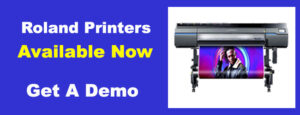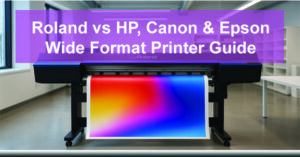Roland vs. the Competition: Which Wide Format Printer Is Right for Your Colorado Print Shop?
If you’re in the market for a wide format printer for your Colorado print shop, you’re likely weighing several options. Canon, Epson, HP, and Roland are all trusted names in the industry, each offering their own strengths when it comes to print quality, speed, media handling, and overall cost of ownership.
But as you narrow down your shortlist, it’s important to dig deeper than brand recognition. You need to know which solution fits your business goals, your production volume, and your customer demands—not just now, but well into the future.
In this post, we’ll compare Roland wide format printers with competitive models from Canon, HP, and Epson, helping you make an informed decision during this crucial consideration phase.
What Should You Look for in a Wide Format Printer?
Before we compare models, take a moment to define what really matters to your business. Are you prioritizing color accuracy? Media versatility? Cutting capability? Here are key features most Colorado print shops should evaluate:
-
Print quality and resolution
-
Speed vs. consistency
-
Media compatibility
-
Integrated cutting
-
Ink durability and cost
-
Ease of maintenance
-
Software and workflow integration
-
Support and training
By aligning your needs with the strengths of each brand, you’ll end up with a printer that boosts productivity and delivers ROI.
Print Quality: Roland vs. Canon, HP, and Epson
Let’s start with the most visible factor—print quality.
Roland
Roland printers, particularly the TrueVIS VG3, offer outstanding color vibrancy thanks to their TrueVIS™ ink technology and advanced Piezo print heads. Roland is especially strong in producing bold, eye-catching prints suited for signage, vehicle wraps, wall graphics, and labels.
-
Strengths: Bright color gamut, excellent gradients, durable inks
-
Best for: Outdoor signage, commercial graphics, retail branding
Canon
Canon’s imagePROGRAF PRO and GP series are known for fine art and photographic precision. They excel in smooth gradations and grayscale accuracy, making them a top pick for photographers and high-end print studios.
-
Strengths: Superior detail for photo printing, pigment inks for archival quality
-
Best for: Fine art reproduction, photography, high-end poster work
HP
HP’s Latex and DesignJet series deliver reliable color output with water-based or latex inks. Latex models offer solid color performance for signage, though they may fall slightly behind Roland in vibrancy for wrap and vinyl applications.
-
Strengths: Eco-conscious latex ink, wide range of applications
-
Best for: Indoor signage, environmental branding, low-emission spaces
Epson
Epson’s SureColor series, particularly the S-Series for signage and P-Series for photo applications, are celebrated for detail and tone reproduction. They rival Canon in the fine art and photo realm.
-
Strengths: PrecisionCore print heads, deep blacks, and tonal range
-
Best for: Photography, gallery prints, interior decor
Bottom Line:
If your business revolves around vivid, durable, and versatile graphics, Roland holds the advantage. For ultra-precise photo reproduction, Canon or Epson might be better suited.
Media Versatility: A Key Differentiator
You may serve a variety of industries—retail, construction, events, or hospitality—and each one comes with different material demands.
Roland
Roland is built for adaptability. From heat transfer vinyl to metallic films, banner stock, and vehicle wrap materials, Roland printers are optimized to print on a wide variety of substrates. Many Roland models also support print-and-cut workflows, making them especially useful for sticker, decal, and apparel markets.
-
Bonus: Integrated contour cutting eliminates the need for a separate cutter.
Canon
Canon’s wide format printers are more limited in material support. They focus primarily on paper-based media and canvas, with some support for vinyl and posters. You won’t find built-in cutting capabilities in most Canon units.
HP
HP Latex printers shine in their ability to print on flexible and rigid substrates, including textiles, wallpapers, window films, and synthetics. Latex prints are also odorless, a plus for indoor installs.
Epson
Epson printers, particularly the SureColor S-Series, handle common signage materials well, including vinyl and backlit film. However, they tend to have fewer options than Roland when it comes to specialty or niche materials.
Bottom Line:
If you need maximum substrate flexibility, Roland or HP Latex are your top choices. For creative shops that do a lot of decals, apparel, and wrap work, Roland’s print-and-cut functionality adds significant value.
| Feature | Roland | Canon | HP | Epson |
|---|---|---|---|---|
| Best For | Signage, vehicle wraps, decals, apparel | Fine art, photography, posters | High-volume indoor/outdoor signage | Photography, interior decor, fine art |
| Print Quality | High color vibrancy, durable inks | Extremely accurate for photos & grayscale | Strong color with fast-drying latex inks | Detailed gradients, rich black tones |
| Speed vs. Precision | Balanced speed + precision | Slower, optimized for photo precision | Fastest in large-scale output | Moderate speed, high precision |
| Media Flexibility | Excellent: vinyl, film, canvas, textiles | Good: mostly paper-based and canvas | Excellent: textiles, wallpaper, film | Good: standard signage & photo media |
| Print & Cut Integration | ✅ Built-in print-and-cut workflow | ❌ Requires external cutter | ❌ Requires external cutter | ❌ Requires external cutter |
| Ink Technology | Eco-solvent (TrueVIS), GREENGUARD certified | Pigment (archival quality) | Latex (odorless, instant dry) | Solvent & pigment (varies by model) |
| Maintenance | Low: Self-cleaning, alerts via mobile app | Moderate: Requires regular nozzle checks | Moderate-High: Requires service contracts | Moderate: Heads prone to clogging |
| Software Integration | VersaWorks 6 (intuitive + powerful) | Print & Layout (photo-focused) | Advanced RIP (more complex to operate) | Edge Print (great for photo workflows) |
| Support & Warranty | Strong dealer support + training options | Good, mostly for photo/graphic support | Good for large-scale operations | Good for color-critical users |
| Total Cost of Ownership | ✅ Cost-effective over time | ❌ Higher ink costs for high volumes | ❌ Higher up-front + printhead costs | Moderate depending on usage |
Print Speed vs. Workflow Efficiency
When you’re up against a tight deadline or a last-minute client request, speed and reliability are non-negotiable.
Roland
Roland wide format printers aren’t the fastest in raw speed compared to HP, but they excel in workflow efficiency. With built-in cutting and automated calibration features, you reduce manual intervention. That saves real time in high-volume environments.
-
Ideal for: Small to mid-sized print shops that prioritize accuracy and hands-off operation
Canon & Epson
Canon and Epson printers are generally slower in high-coverage graphics and signage applications. They focus more on precision than speed. That said, for fine art and photo reproduction, this slower pace ensures detail accuracy.
HP
HP Latex printers tend to be among the fastest in the wide format category. Their high-throughput design makes them ideal for large shops with rapid job turnover. However, these printers are bulkier, more expensive, and may require more space and power.
Bottom Line:
If you’re balancing speed and flexibility, Roland offers the best of both in most real-world applications. If raw speed for large volume is your top priority, HP Latex is worth considering—but be ready for higher upfront and operating costs.
Maintenance and Total Cost of Ownership
Let’s talk about what it costs to own and operate your printer—not just today, but year after year.
Roland
Roland printers are known for low maintenance requirements and long-lasting components. You’ll find smart features like self-cleaning heads and ink usage monitoring via the Roland DG Connect app, which helps prevent surprises.
-
Inks: TrueVIS inks are competitively priced and have long shelf life
-
Support: Strong dealer network and warranty support
Canon & Epson
Canon and Epson both offer low ink consumption for photographic work, but maintenance tends to be more frequent. Clogged nozzles and head alignment can require attention, especially with pigment inks.
HP
HP’s Latex inks are more expensive per ml, but they dry instantly and don’t require off-gassing, reducing finishing time. However, replacement printheads can add up, and service contracts may be needed due to system complexity.
Bottom Line:
For shops that want predictable costs, low maintenance, and solid support, Roland offers the best mix of simplicity and value.
** Editor’s note: ABT has a wide variety of inks and toners on site, and even more available quickly. Reach out here if you need help ordering Toner and Inks!
Software and Workflow Integration
Getting the most from your printer also means having software that fits smoothly into your workflow.
Roland
With Roland’s VersaWorks 6 RIP software, you get a user-friendly interface, intuitive nesting tools, color matching, and support for variable data. It’s designed for efficiency, even if you’re not a software expert.
Canon & Epson
Canon offers the Professional Print & Layout software, while Epson provides Epson Edge Print. Both are solid for color-critical photo printing but may be limiting for high-volume signage work.
HP
HP’s RIP software is robust and highly customizable. However, it tends to be more complex and may require extra training.
Bottom Line:
For a balance of power and ease of use, Roland’s VersaWorks is a standout. It’s ideal for growing print shops that need powerful tools without a steep learning curve.
Final Thoughts: Roland Is the Strategic Choice for Versatile Print Shops
When it comes to graphic-intensive, high-impact, and versatile print work, Roland wide format printers consistently stand out as a smart investment. While Canon and Epson dominate the fine art and photo printing space, and HP offers speed and scalability, Roland strikes a powerful balance of performance, durability, and workflow integration.
For Colorado print shop owners serving diverse clients—from real estate and retail to events and vehicle graphics—a Roland wide format printer gives you:
-
Vibrant color and precision output
-
Integrated print-and-cut capabilities
-
Broad media compatibility
-
Low maintenance and excellent ROI
-
Smart workflow tools to keep you efficient
Still Deciding? Let’s Talk.
Choosing a wide format printer is a big decision—and getting it right means understanding the nuances of each brand. At ABT, we help print professionals like you compare options in real-world conditions, so you can choose confidently.
Need a demo or side-by-side comparison?
Contact us today for expert advice, flexible financing, and personalized support to find the perfect fit for your print business.

